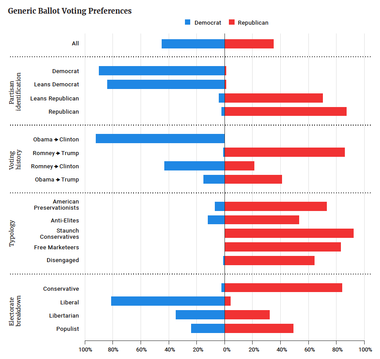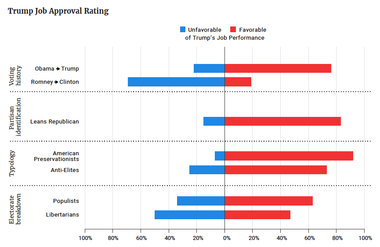
Key Findings
In May, the Democracy Fund Voter Study Group completed its 2018 VOTER Survey (Views of the Electorate Research Survey), which shows Democrats have a 10-point lead on the generic congressional ballot and President Donald Trump with only a 40 percent job approval rating. The easy takeaway — voter support for Democrats is directly tied to their disapproval of Trump — is not, however, completely accurate. The VOTER Survey’s unique size and longitudinal nature means it can capture trends and beliefs in much smaller subgroups of the electorate than is possible with most other surveys. Analysis of some of these subgroups reveals that much of the Republican weakness on the generic ballot comes from the current unwillingness of some Trump supporters to commit to his party’s congressional candidates.
The VOTER Survey’s attributes also allow us to note how movement among specific subgroups is likely to have different effects on House and Senate races. The Democratic Party’s path to a House majority runs through the 24 Republican-held House seats, which Hillary Clinton won in 2016. Many of these seats were carried by Mitt Romney just four years previously, making the “Romney-Clinton” voters the key group likely to determine the outcomes of these contests.
The Republican path to picking up Senate gains, however, runs through the ten Democrat-held states carried by President Trump. Five of these states had been carried by President Barack Obama four years prior, and Trump received significantly higher shares of the vote than did Mitt Romney in the other five. This shows that “Obama-Trump” voters will decide whether the Republican Party can retain or strengthen its hold on the Senate.
The VOTER Survey also provides meaningful information about the current proclivities of these key voter subgroups. The data currently show that Romney-Clinton voters — about three percent of the total electorate, but a much larger share in the 24 states whose House seats are most important — are very likely to support Democratic congressional candidates this fall, which enhances that party’s ability to win the House. On the other hand, Obama-Trump voters — about five percent of the electorate, but a much larger share in the Democratic-held seats of Indiana, Missouri, Montana, North Dakota, and West Virginia, — are split between supporting the G.O.P. and feeling unsure which party’s candidates to support. The same data, therefore, suggest very different potential outcomes between the House and Senate in this fall’s midterms.
A significant portion of the Democratic lead on the generic ballot stems from lower degrees of support for Republicans among the less partisan elements of the Trump/G.O.P. voter coalition. A number of measures for assessing Trump/G.O.P. attachment bear this out.
Figure 1 uses three different measures of assessing partisan support and depicts each subgroup’s responses to the generic congressional ballot. The first measure is self-reported degrees of attachment to the Democratic or Republican party. The second uses the five-part typology of Trump general election voters created by Voter Study Group member and Cato Institute scholar Emily Ekins as part of her report, “The Five Types of Trump Voters.” And the third uses the four-part breakdown of the total 2016 electorate created by Voter Study Group member and New America scholar Lee Drutman in his 2017 report, “Political Divisions in 2016 and Beyond.” In each case, we see that the groups least firmly attached to the Republican Party but which were generally supportive of President Trump are less supportive of Republican congressional candidates than one might expect.
Figure 1

The first measure looks at self-reported partisan identification and voting history. As one can see, Republican-leaners back Republican congressional candidates by only a net 66 percent while Democratic-leaners back Democratic candidates by a net 83 percent margin. Similarly, cross-pressured Republicans (Romney-Clinton voters) give Democratic candidates a net 22 percent advantage while their Democratic counterparts, Obama-Trump voters, give Republican candidates a net 26 percent margin. Indeed, more Obama-Trump voters (44 percent) say they are either unsure who to back or do not plan to vote for either party’s candidates than say they will back Republicans.
These facts have different implications for each party. For the Republican Party, shoring up soft Republican or Trump support is the fastest way to close the generic ballot gap. For Democrats, only slightly increasing their current share among these groups could prevent a significant Republican resurgence.
The same point holds when we use Emily Ekins’ measure. Ekins found that people who voted for Trump in 2016 broke into five discrete categories. Two of these categories, the American Preservationists and the Anti-Elites, contained large numbers of voters who had either voted for President Obama or considered themselves to be Democrats in 2012. About 40 percent of Trump’s voters fell into one of these categories. These two groups each give Republican congressional candidates significantly lower shares of their votes than the two groups that contain mostly traditional Republican partisans, the Staunch Conservatives and the Free Marketeers.
Again, this situation provides each party with significant challenges and opportunities. For Republicans, increasing G.O.P. support among the groups supportive of Trump but less connected to the Republican Party could dramatically increase their standing on the generic ballot test. For Democrats, two approaches — wooing some former Democrats back or discouraging these voters from casting ballots at all — could maintain their current advantage.
Lee Drutman’s method of analyzing the electorate shows Republican weakness is especially concentrated among the two groups whose views on issues place them between hardcore Republicans and Democrats. People who hold mainly liberal views on economic and on identity questions comprise about 41 percent of all American voters according to Drutman’s 2017 report, and they back Democrats for Congress this year by an 81 to 4 margin. People, who hold conservative views on both sets of issues, comprise only about a quarter of all American voters, but they give Republicans a similarly lopsided 84 to 2 advantage on this year’s generic ballot. Ten percent of all voters are Libertarians (conservative on economics and liberal on identity issues), and while they supported Trump by a 35 to 31 margin in 2016, they currently give Democrats a 35 to 32 edge in the generic ballot.
The most important group in Drutman’s analysis, Populists, are the reason Democrats have a large lead in this year’s Congressional races. Populists, about 29 percent of all voters, hold liberal views on economic measures but conservative ones on identity questions. Over 65 percent voted for Trump in 2016, but this group currently gives Republicans only 49 percent of their support for Congress. Their support for Democratic congressional candidates, 24 percent, is nearly identical to the support they gave to Hillary Clinton (21 percent). The 27 percent who are not currently backing either party’s candidates were nearly all Trump voters just eighteen months ago. Which party these voters back — or whether they will vote at all — will be crucial to determining the outcome this fall, especially in the hot Senate races.
These data turn conventional midterm strategy on its head. The conventional approach, articulated by leading Republican Party consultant Jeff Roe in a March op-ed in The New York Times, holds that midterm elections are about partisan enthusiasm and turnout. Motivate a party’s base to vote and you maximize your party’s chance to prevail.
VOTER Survey data suggests, instead, that Republicans must instead focus on persuading less partisan Trump backers to first back Republicans and then turn out to vote. The VOTER Survey data show that partisan Republicans are already extremely likely to vote for Republican congressional candidates. The reason Republicans are behind is because former Romney backers now plan to back Democrats and, more important, less-partisan Trump backers are not supporting Republicans with the margins needed to win. Successful Republican congressional candidates, therefore, need to both motivate their base to turn out AND persuade cross-pressured voters to back them.
The data also challenges Democratic campaign orthodoxy. Many strategists argue that current Democratic partisan enthusiasm will be the key to turning the generic ballot advantage into a “blue wave.” But these VOTER Survey data suggest that even such an advantage will not produce a Democratic landslide if cross-pressured Trump voters end up backing Republicans. To prevent that, Democratic campaigns in any seat or state with a large number of Obama-Trump or Romney-Clinton voters must address the concerns of these subgroups.
Republicans seem to hold a slight advantage in the contest for cross-pressured voters’ loyalty because some of these groups currently rate their approval of the job President Trump is doing more highly than they do their support for Republicans on the generic congressional ballot. However, these data also show that Democrats would increase their advantage if they could convince Romney-Clinton and Libertarian voters who don’t like Trump to give Democrats a higher share of their votes as well.
Figure 2

The job approval ratings that each of these cross-pressured subgroups gives President Trump differs from how they rate their likelihood to vote for Democrats or Republicans (Figure 2). For groups that voted for Trump in 2016 or which normally vote Republican, closing that gap works in the Republicans’ favor. Seventy-six percent of Obama-Trump voters, for example, give approve of Trump’s job performance. Yet only 41 percent in this group say they are currently thinking of voting Republican. The gap is as large among Populists (63 approval, 49 percent G.O.P.) and nearly as large among American Preservationists (92 percent approval, 73 percent G.O.P.) and Anti-Elites (73 percent approval, 56 percent G.O.P.). Simply getting Trump voters who still approve of Trump to support Republican candidates would probably significantly reduce the Republican gap with Democrats.
Democrats have similar opportunities among Romney-Clinton voters and Libertarians. 69 percent of Romney-Clinton voters disapprove of Trump, yet only 43 percent say they plan to vote Democratic. Similarly, 50 percent of Libertarians disapprove of Trump, yet only 35 percent plan to vote Democratic in the fall. Aligning these voters’ views of Trump and Democratic candidates could offset some Republican gains and make Democratic victory more likely.
It is always foolish to predict an election outcome with any degree of certainty four months out. That does not mean, however, that one cannot accurately predict the field wherein the election battle will be fought. The 2018 VOTER Survey shows that Democrats go into the fall with significant advantages in terms of the engagement and loyalty of their base, as well as their ability to engage the support of key crossover voter groups such as Romney-Clinton and Libertarian voters. Republicans, however, have room to grow the levels of support and engagement within their base, and have a significant opportunity to raise their chances by engaging and mobilizing the nontraditional portions of their coalitions.
If the fall campaign turns into a battle of the traditional bases, and no significant disruption — like a recession, financial collapse, presidential indictment, or major international crisis — occurs, we should expect Democrats to do very well in the House and the Senate. If Democrats can convince large numbers of nontraditional, anti-Trump Democrats to support them, a victory could turn into a wave. Should, however, Republicans successfully engage with the nontraditional elements of their coalition, they could hold the level of their losses in the House to a low enough number to retain control, while simultaneously taking advantage of the highly favorable Senate map to significantly pad their majority.
Subscribe to our mailing list for updates on new reports, survey data releases, and other upcoming events.